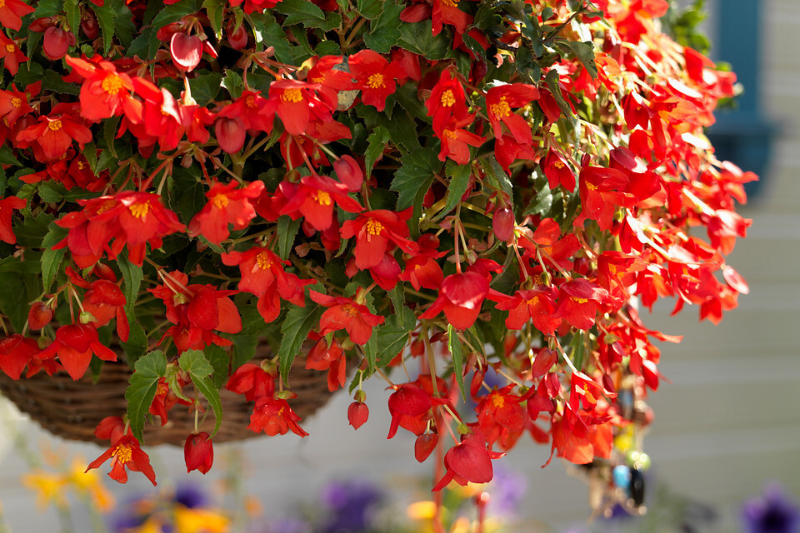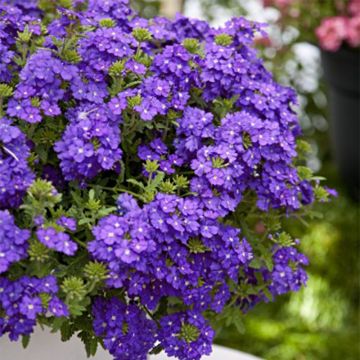

Zinnia Profusion Double mélange Mini-mottes


Zinnia Profusion Double mélange Mini-mottes
Zinnia Profusion Double Mix
Zinnia Profusion Double Mix
Common Zinnia, Elegant Zinnia, Youth-and-old-age
They disappear into the ground. I believe I can only spot 4 or 5 of them. I won't take any more small clumps.
Monique, 25/05/2023
Special offer!
Receive a €20 voucher for any order over €90 (excluding delivery costs, credit notes, and plastic-free options)!
1- Add your favorite plants to your cart.
2- Once you have reached €90, confirm your order (you can even choose the delivery date!).
3- As soon as your order is shipped, you will receive an email containing your voucher code, valid for 3 months (90 days).
Your voucher is unique and can only be used once, for any order with a minimum value of €20, excluding delivery costs.
Can be combined with other current offers, non-divisible and non-refundable.
Home or relay delivery (depending on size and destination)
Schedule delivery date,
and select date in basket
This plant carries a 6 months recovery warranty
More information
We guarantee the quality of our plants for a full growing cycle, and will replace at our expense any plant that fails to recover under normal climatic and planting conditions.
Would this plant suit my garden?
Set up your Plantfit profile →
Description
The Zinnias 'Profusion Double' mix, with their double flowers in vibrant colours and compact habit, is perfect for brightening up flower beds and containers for long weeks, from summer to autumn. White, fuchsia pink, yellow, variegated orange with pink-red, the flowers bloom abundantly on small, well-groomed vigorous plants that are both disease-resistant and low-maintenance. These generous annual plants are truly easy to grow in the sun and require very little care.
Zinnia marylandica Profusion Double is an interspecific hybrid obtained through the artificial cross-breeding of Z. angustifolia var. angustifolia and Z. violacea, both belonging to the Asteraceae family. Both are also native to the north and west of Mexico. This Profusion Double Zinnia forms a well-branched and bushy clump measuring 30 to 40 cm (12 to 16in) in height and 40 to 50 cm (16 to 20in) in width within a few weeks. The sturdy stems are covered with rough and fuzzy, lanceolate to elliptical leaves of medium green. This selection brings together plants with a uniform and regular habit, particularly resistant to fungal diseases, heat, and drought. Their remarkably long flowering period extends from June-July to November, and they are nectar-rich and attractive to pollinating insects. The flower is a 5 cm (2in) diameter head, well double and open, with several rows of ligulate petals of varying colour depending on the plants, surrounding a central disc composed of tiny golden flowers. After pollination by insects, the flowers give way to seeds that readily self-sow in light soils.
Watching zinnias grow is always a surprise. Capable of emerging from the ground in the most unlikely places, abandoned by many plants, their flowers flourishing even in gravelly soils and scorching sun. Their vibrant hues blend so well with the relentless summer light and light-coloured gravel beds that they can be allowed to grow even in patio cracks or pathways. Even though they are born and die in the same year, it's worth enjoying their endless flowering to the limits of reason. They stand out in wildflower meadows and above walls; their intensity can be tempered by pairing them with softer blooms, such as white or blue love-in-a-mist, cosmos, white gauras, or by placing them amidst light grasses like Stipa tenuifolia or Eragrostis trichoides. Of course, they can be planted in pots to decorate the patio in summer, with almost no maintenance required.
Note: Please be aware that our young plug plants are professional products intended for experienced gardeners. Upon receipt, transplant and store them in a sheltered place (veranda, greenhouse, cold frame...) at a temperature above 14°C (57.2°F) for a few weeks before planting them outdoors once the risk of frost has passed.
Zinnia Profusion Double Mix in pictures




Flowering
Foliage
Plant habit
Botanical data
Zinnia
Profusion Double Mix
Asteraceae
Common Zinnia, Elegant Zinnia, Youth-and-old-age
Cultivar or hybrid
Planting and care
Zinnias are easy-to-grow plants that can be planted in the spring, once the risk of frost has passed. They prefer well-drained soils, even sandy or rocky ones, but fertile enough to support their flowering, and require a very sunny exposure. To prolong the flowering, remove faded flowers as they appear, so that the plant does not exhaust itself in producing seeds. In pots, water regularly and provide fertiliser for flowering plants.
Planting period
Intended location
Care
Planting & care advice
-
, onOrder confirmed
Reply from on Promesse de fleurs
Similar products
Haven't found what you were looking for?
Hardiness is the lowest winter temperature a plant can endure without suffering serious damage or even dying. However, hardiness is affected by location (a sheltered area, such as a patio), protection (winter cover) and soil type (hardiness is improved by well-drained soil).

Photo Sharing Terms & Conditions
In order to encourage gardeners to interact and share their experiences, Promesse de fleurs offers various media enabling content to be uploaded onto its Site - in particular via the ‘Photo sharing’ module.
The User agrees to refrain from:
- Posting any content that is illegal, prejudicial, insulting, racist, inciteful to hatred, revisionist, contrary to public decency, that infringes on privacy or on the privacy rights of third parties, in particular the publicity rights of persons and goods, intellectual property rights, or the right to privacy.
- Submitting content on behalf of a third party;
- Impersonate the identity of a third party and/or publish any personal information about a third party;
In general, the User undertakes to refrain from any unethical behaviour.
All Content (in particular text, comments, files, images, photos, videos, creative works, etc.), which may be subject to property or intellectual property rights, image or other private rights, shall remain the property of the User, subject to the limited rights granted by the terms of the licence granted by Promesse de fleurs as stated below. Users are at liberty to publish or not to publish such Content on the Site, notably via the ‘Photo Sharing’ facility, and accept that this Content shall be made public and freely accessible, notably on the Internet.
Users further acknowledge, undertake to have ,and guarantee that they hold all necessary rights and permissions to publish such material on the Site, in particular with regard to the legislation in force pertaining to any privacy, property, intellectual property, image, or contractual rights, or rights of any other nature. By publishing such Content on the Site, Users acknowledge accepting full liability as publishers of the Content within the meaning of the law, and grant Promesse de fleurs, free of charge, an inclusive, worldwide licence for the said Content for the entire duration of its publication, including all reproduction, representation, up/downloading, displaying, performing, transmission, and storage rights.
Users also grant permission for their name to be linked to the Content and accept that this link may not always be made available.
By engaging in posting material, Users consent to their Content becoming automatically accessible on the Internet, in particular on other sites and/or blogs and/or web pages of the Promesse de fleurs site, including in particular social pages and the Promesse de fleurs catalogue.
Users may secure the removal of entrusted content free of charge by issuing a simple request via our contact form.
The flowering period indicated on our website applies to countries and regions located in USDA zone 8 (France, the United Kingdom, Ireland, the Netherlands, etc.)
It will vary according to where you live:
- In zones 9 to 10 (Italy, Spain, Greece, etc.), flowering will occur about 2 to 4 weeks earlier.
- In zones 6 to 7 (Germany, Poland, Slovenia, and lower mountainous regions), flowering will be delayed by 2 to 3 weeks.
- In zone 5 (Central Europe, Scandinavia), blooming will be delayed by 3 to 5 weeks.
In temperate climates, pruning of spring-flowering shrubs (forsythia, spireas, etc.) should be done just after flowering.
Pruning of summer-flowering shrubs (Indian Lilac, Perovskia, etc.) can be done in winter or spring.
In cold regions as well as with frost-sensitive plants, avoid pruning too early when severe frosts may still occur.
The planting period indicated on our website applies to countries and regions located in USDA zone 8 (France, United Kingdom, Ireland, Netherlands).
It will vary according to where you live:
- In Mediterranean zones (Marseille, Madrid, Milan, etc.), autumn and winter are the best planting periods.
- In continental zones (Strasbourg, Munich, Vienna, etc.), delay planting by 2 to 3 weeks in spring and bring it forward by 2 to 4 weeks in autumn.
- In mountainous regions (the Alps, Pyrenees, Carpathians, etc.), it is best to plant in late spring (May-June) or late summer (August-September).
The harvesting period indicated on our website applies to countries and regions in USDA zone 8 (France, England, Ireland, the Netherlands).
In colder areas (Scandinavia, Poland, Austria...) fruit and vegetable harvests are likely to be delayed by 3-4 weeks.
In warmer areas (Italy, Spain, Greece, etc.), harvesting will probably take place earlier, depending on weather conditions.
The sowing periods indicated on our website apply to countries and regions within USDA Zone 8 (France, UK, Ireland, Netherlands).
In colder areas (Scandinavia, Poland, Austria...), delay any outdoor sowing by 3-4 weeks, or sow under glass.
In warmer climes (Italy, Spain, Greece, etc.), bring outdoor sowing forward by a few weeks.


















































